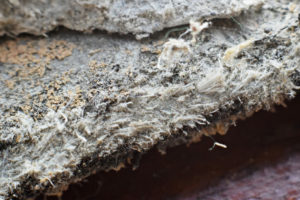Pleural Diseases
Pleural diseases affect the pleura, the lining of the lungs. Many pleural diseases are caused by exposure to asbestos, a carcinogenic (cancer-causing) fibrous mineral. Examples include pleural mesothelioma, pleural effusions, pleural plaques, and more. Learn more about pleural diseases and if you might be eligible for resources to help pay for treatment.
How Asbestos Leads to Pleural Diseases
Asbestos is a highly durable mineral used in a wide range of products and industries. Unfortunately, the fibers are incredibly dangerous, and millions of people may be at risk of developing pleural diseases after being exposed to asbestos.
 When asbestos-containing products are disturbed, the microscopic fibers are released into the air. The fibers may then be inhaled or ingested, allowing the material to settle within the body.
When asbestos-containing products are disturbed, the microscopic fibers are released into the air. The fibers may then be inhaled or ingested, allowing the material to settle within the body.
The body cannot break down or remove these fibers. Instead, the asbestos fibers can settle in the lung lining, causing irritation, inflammation, and eventually, pleural diseases.
It may take 10-50 years for these conditions to develop because asbestos has a long latency period. Many people who were exposed decades ago may still be at risk of developing asbestos-related pleural diseases. Thankfully, there are resources available to those harmed by asbestos.
If you were diagnosed with a pleural disease, learn what financial compensation you might be eligible for with a Free Case Review.
- Access Financial Aid and Justice
- Learn About Your Options
- Contact Us for Free

Types of Asbestos-Related Pleural Diseases
There are several asbestos-related pleural diseases, including mesothelioma, pleural effusions, pleural plaques, and pleural thickening. Some patients may develop multiple asbestos-related pleural diseases at once.
Learn about common pleural diseases and their symptoms below.
Mesothelioma
Malignant pleural mesothelioma is a deadly, aggressive cancer that affects the pleura, the lining of the lung. The only known cause of mesothelioma is asbestos.
Signs and symptoms of pleural mesothelioma may include:
- Chest pain
- Fatigue
- Persistent cough
- Shortness of breath
Approximately 2,400 people are diagnosed with pleural mesothelioma every year. While the prognosis is often poor, some pleural mesothelioma patients can achieve long-term survival through treatment.
Pleural Effusion
Pleural effusion is the buildup of excess fluid in the chest cavity.
Symptoms of a pleural effusion may include:
- Chest pain
- Difficulty breathing
- Dry cough
- Increased heart rate
A common pleural effusion subtype is empyema, which is the accumulation of pus in the pleural cavity. It is often associated with pneumonia.
Pleural Plaques
Pleural plaques are benign (non-cancerous) areas of thickened tissue that form in the pleura. Unlike pleural thickening, which is more widespread, they only form in small areas.
Pleural plaques may not cause significant symptoms. However, they are a sign of asbestos exposure and increase someone’s risk of developing serious malignancies like asbestos-related lung cancer or mesothelioma.
If you are experiencing symptoms such as chest pain or difficulty breathing, talk with your doctor as soon as possible. These symptoms along with pleural plaques could be signs of a more serious lung disease.
Pleural Thickening
Pleural thickening occurs when the lung lining becomes inflamed and scarred. This can lead to hardening and thickening of the lining.
Like pleural plaques, pleural thickening is usually benign and has minimal impact on a person’s life span or lung function. However, some patients may have some difficulty breathing.
Pleural thickening can be unilateral (affecting one lung) or bilateral (affecting both lungs).
Pleurisy
Also known as pleuritis, pleurisy occurs when the two pleura layers become inflamed.
Between the two layers of the pleura is a small space that fills with fluid to allow the lungs to move freely when breathing in and out. When the layers become inflamed, the space closes, causing the two layers to rub against each other. This can make it painful for the lungs to expand and contract.
Symptoms of pleurisy include:
- Chest pain
- Cough
- Shortness of breath
Pneumothorax
If lung tissue is damaged, it can be possible for air to build up in the pleural space. When too much air builds up, it can cause a partial or complete lung collapse known as pneumothorax.
Symptoms of pneumothorax may include:
- Difficulty breathing
- Sudden chest pain
This condition ranges in severity. Some patients may be able to recover from a small partial lung collapse with rest. However, in some cases, a pneumothorax can be life threatening.
Who Is At Risk of Pleural Diseases?
Those who were exposed to asbestos in high amounts nearly every day for long spans of time (months or years) are more likely to develop one or more pleural diseases.
High-risk asbestos occupations include:
- Aircraft and vehicle repair
- Construction work
- Mining
- Shipbuiding
- U.S. military service
 Since there is no safe amount of asbestos, secondhand exposure also puts many more people at risk of developing pleural diseases. Those living with people who worked in high-risk occupations may have been exposed to asbestos that settled on clothing and eventually released in the home.
Since there is no safe amount of asbestos, secondhand exposure also puts many more people at risk of developing pleural diseases. Those living with people who worked in high-risk occupations may have been exposed to asbestos that settled on clothing and eventually released in the home.
If you were exposed to asbestos and later developed pleural diseases or cancer, you may be eligible for financial assistance to help pay for treatment and therapy.
Contact the Lung Cancer Group team at (877) 446-5767 to see how we can help you.
Diagnosing Asbestos-Related Pleural Diseases
Doctors may use a variety of diagnostic tests and screens to spot pleural diseases.
Diagnostic tests for pleural diseases include:
- Chest X-rays: With an X-ray, doctors can see inside the chest and lungs. This is usually the first imaging test used to look for problems in the chest cavity.
- Computed tomography (CT) scans: CT scans are more detailed than X-rays. These scans take cross-sectional and 3D images of bones, tissues, and organs.
- Magnetic resonance imaging (MRI) scans: MRIs are more involved than CT scans and use powerful radiofrequency waves, a computer, and magnets to create detailed images of tissues, blood vessels, and bones.
- Other tests: Blood tests and positron emission tomography (PET) scans may also be used to detect the presence of malignant pleural diseases.
If doctors suspect a patient has pleural mesothelioma tumors, they may order a biopsy to confirm a cancer diagnosis. Through biopsies, doctors take tissue or fluid samples to examine in a lab in more detail.
Treatments for Pleural Diseases
Treatments for asbestos-related pleural diseases vary. Learn about specific treatment options for pleural diseases below.
Mesothelioma Treatment
Standard pleural mesothelioma treatments include:
- Surgery: Doctors may use various surgical procedures to remove pleural tumors if the patient is in good overall health and if the cancer hasn’t spread very far. Doctors will also want to remove the pleura and possibly the lung closest to the cancer as well.
- Chemotherapy: Chemotherapy uses drugs to slow the growth of cancer cells.
- Immunotherapy: Immunotherapy boosts the body’s immune system to fight cancer.
- Radiation therapy: Also known as radiotherapy, radiation therapy uses high-energy X-rays and other types of radiation to kill cancer cells and prevent them from growing.
Pleural Effusion Treatment
Doctors can treat pleural effusions with the following:
- Thoracentesis: This involves putting a needle into the chest to remove fluid from the pleural cavity.
- Drainage: Doctors may attach a catheter or chest tube to drain the excess fluid if a thoracentesis does not remove enough fluid.
- Pleurodesis: This procedure sticks the lung to the chest wall to eliminate the pleural space. As a result, fluid can no longer build up. Doctors may use a sclerosing agent (a type of drug that deliberately causes scarring) to seal the lung lining. According to Cleveland Clinic, this is 50% successful in preventing pleural effusions from recurring (coming back).
- Surgery: Doctors may perform video-assisted thoracoscopic surgery (VATS) and thoracotomy to treat pleural effusions that can’t be managed through pleurodesis or drainage.
Pleural Plaques Treatment
Pleural plaques do not usually require treatments, especially since they do not cause any serious symptoms or discomfort. Doctors may suggest lifestyle changes to help keep the lungs strong. See a doctor if you start feeling worse after being diagnosed with pleural plaques.
Pleural Thickening Treatment
As with pleural plaques, pleural thickening usually does not require treatments, since it doesn’t cause severe symptoms.
Lifestyle changes like keeping active and stopping smoking are usually the most helpful options. Doctors may also recommend pulmonary rehabilitation to strengthen your lungs and increase your quality of life.
Pleurisy Treatment
Treatment for pleurisy may vary depending on what doctors believe is the underlying cause. If they think more serious conditions like mesothelioma or lung cancer may be causing the irritation, they may recommend treatments specific to those conditions.
However, if there are no other signs of malignant pleural diseases, doctors may recommend rest and medications to help ease the inflammation.
Pneumothorax Treatment
Depending on the severity of the pneumothorax, treatment will vary for this condition. In less severe cases, doctors will typically observe the lung through chest X-rays until the lung expands.
In more severe cases, treatment may include:
- Chest tube insertion or needle aspiration: Both a chest tube insertion and needle aspiration focus on draining the excess air from the pleural space to allow the lung to re-expand.
- Nonsurgical repair: This treatment focuses on closing the air leak with either an irritative substance or by drawing blood and applying it to the lung to heal the leak.
- Surgery: In rare cases, surgery may be needed to seal the air leak and re-expand the lung.
Treatment for any type of pleural disease can be costly, but we may be able to help you pay for treatment. Contact us today if you believe your pleural disease was caused by asbestos.
Prognosis of Asbestos Pleural Diseases
 The prognoses or expected outcomes for asbestos-related pleural conditions vary depending on the disease.
The prognoses or expected outcomes for asbestos-related pleural conditions vary depending on the disease.
Some pleural diseases, like pleural plaques and pleural thickening, do not typically impact a patient’s life expectancy. Other pleural diseases, however, can be serious and even fatal.
Potentially fatal asbestos pleural diseases include:
- Pleural mesothelioma: The prognosis of patients with pleural mesothelioma is generally poor. According to Penn Medicine, patients with the condition typically only live for 4 to 18 months after diagnosis, and the 5-year survival rate is just 10%. Surgery, chemotherapy, and other treatments can improve a patient’s prognosis.
- Pleural effusion: Because patients with pleural effusion often have fatal conditions too, such as lung cancer, the prognosis is generally poor. According to a study in the Journal of Pulmonary & Respiratory Medicine, about one-third of 104 patients who were admitted to the hospital after a pleural effusion died within a year.
- Pneumothorax: The severity of pneumothorax may vary. If patients experience only a partial lung collapse, they may be able to recover without complications. However, in serious cases, some patients may die from a complete lung collapse.
Compensation for Asbestos-Related Pleural Diseases
Treatment for asbestos-related pleural diseases can be expensive, especially if you have recurrent disease.
Fortunately, you can get financial compensation for asbestos-related pleural diseases through asbestos trust fund claims, private claims, and U.S. Department of Veterans Affairs (VA) benefits.
Asbestos Trust Fund Claims
Asbestos trusts were created by bankrupt asbestos companies to compensate victims of asbestos diseases. There is an estimated $30 billion available in trust funds for asbestos victims.
If you have an asbestos-related pleural disease, an experienced asbestos lawyer can help you file a trust fund claim, gather evidence to prove your case, and determine which trust funds you can submit claims to.
An asbestos attorney can also help you file a claim if a loved one died of an asbestos-related condition.
Private Claims
If the asbestos company responsible for your or your loved one’s asbestos exposure is not bankrupt, you can obtain compensation by filing a private asbestos claim or lawsuit.
Filing an asbestos lawsuit lets you recover various non-economic and economic damages, including funeral costs (for a loved one’s wrongful death), medical expenses, loss of consortium, and pain and suffering.
VA Benefits
If you were exposed to asbestos during military service and developed asbestos-related pleural diseases, you may be eligible for VA benefits such as monthly disability payouts, health care services, and much more.
Get Help With Asbestos-Related Pleural Diseases
Receiving a pleural disease diagnosis can be traumatizing and stressful, especially when treatments are often too costly for the average person.
Founded by those whose lives were touched by cancer and other asbestos-related diseases, the Lung Cancer Group team knows how these illnesses can turn lives upside down.
We can help those with asbestos-related pleural diseases find the best financial and legal help available. Contact us today for a free case evaluation.
Asbestos-Related Pleural Diseases FAQs
What is pleural disease?
A pleural disease impacts the thin lining of the lungs. Sometimes caused by asbestos, pleural diseases can be benign (non-cancerous) or malignant (cancerous). It is possible for patients to develop more than one pleural disease.
How does asbestos exposure cause pleural diseases?
When people inhale asbestos fibers, the fibers get stuck in the pleura, the lining of the lung.
Over time, the fibers cause scarring and inflammation of the pleura, leading to conditions like pleural mesothelioma, pleural effusion, and other pleural diseases.
Can you cure pleural diseases?
No, you generally cannot cure asbestos-related pleural diseases, because the body cannot absorb or remove asbestos fibers once you’ve inhaled them.
However, treatments and lifestyle changes can help you cope with the effects of pleural diseases. You can treat almost all pleural diseases in some way.
Talk to your health care team to learn more about your treatment options.

